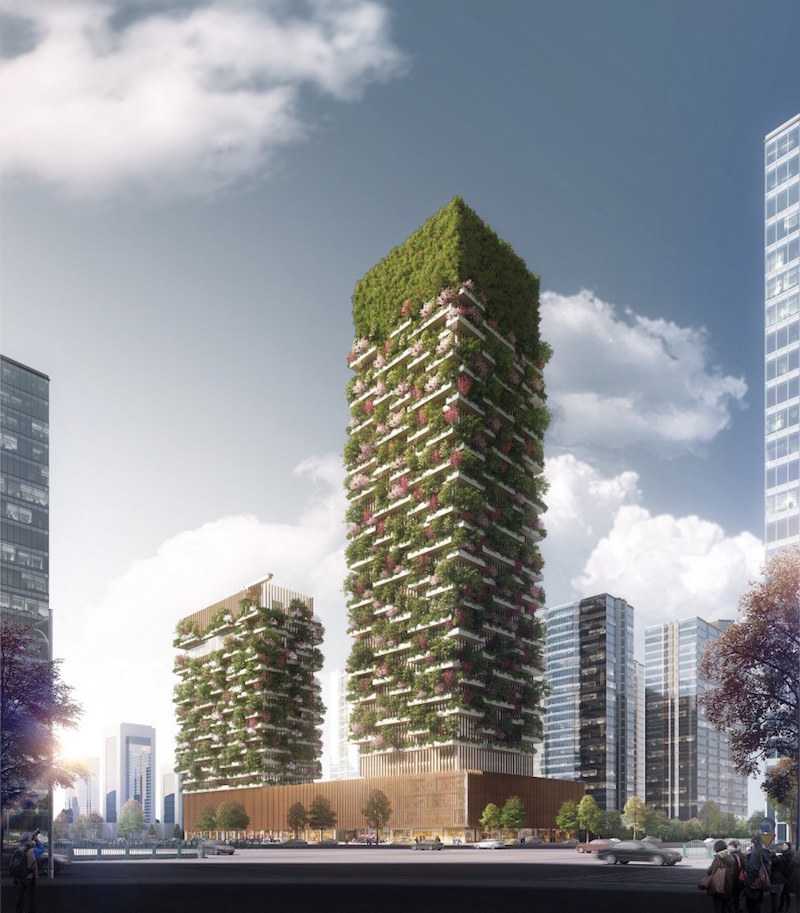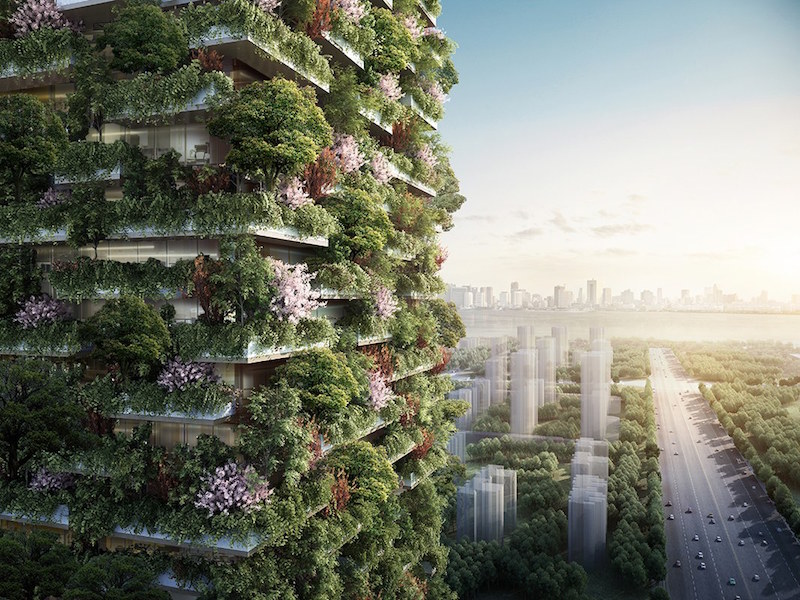A new mixed-use project from Stefano Boeri Architects, Nanjing Vertical Forest will comprise two towers rising from a 20-meter shared podium. What makes this project unique is, according to the architects, this will be the first vertical forest built not only in China, but in all of Asia.
The building’s facades will feature 600 tall trees and 500 medium trees from 23 different local species. Another 2,500 cascading plants and shrubs will be included, as well. In total, the trees and other plants will cover a 6 square mile area and absorb 25 tons of CO2 per year. The plants will also produce about 60 kilograms of oxygen per day. To help put that into perspective, the average person needs 0.84 kilograms of oxygen per day, according to NASA.
One of the towers will rise 200 meters and be topped with a “green lantern” while the other tower will rise 108 meters. The 200-meter tower will include a museum, a green architecture school, and a private rooftop club. The 108-meter tower will house a 247-room Hyatt hotel and a rooftop swimming pool. Both towers will rise from a 20-meter podium that will host retail space, a food market, restaurants, a conference hall, and exhibition spaces.
The project is Stefano Boeri Architects’ third vertical forest prototype, after Milan and Lausanne. The firm plans to bring vertical forests to other Chinese cities such as Guizhou, Shanghai, and Chongqing at a later date. The Nanjing Vertical Forest will be completed in 2018.
 Rendering courtesy of Stefano Boeri Architects.
Rendering courtesy of Stefano Boeri Architects.
 Rendering courtesy of Stefano Boeri Architects.
Rendering courtesy of Stefano Boeri Architects.
Related Stories
| Nov 2, 2010
Yudelson: ‘If It Doesn’t Perform, It Can’t Be Green’
Jerry Yudelson, prolific author and veteran green building expert, challenges Building Teams to think big when it comes to controlling energy use and reducing carbon emissions in buildings.
| Nov 1, 2010
Sustainable, mixed-income housing to revitalize community
The $41 million Arlington Grove mixed-use development in St. Louis is viewed as a major step in revitalizing the community. Developed by McCormack Baron Salazar with KAI Design & Build (architect, MEP, GC), the project will add 112 new and renovated mixed-income rental units (market rate, low-income, and public housing) totaling 162,000 sf, plus 5,000 sf of commercial/retail space.
| Nov 1, 2010
Vancouver’s former Olympic Village shoots for Gold
The first tenants of the Millennium Water development in Vancouver, B.C., were Olympic athletes competing in the 2010 Winter Games. Now the former Olympic Village, located on a 17-acre brownfield site, is being transformed into a residential neighborhood targeting LEED ND Gold. The buildings are expected to consume 30-70% less energy than comparable structures.
| Oct 21, 2010
GSA confirms new LEED Gold requirement
The General Services Administration has increased its sustainability requirements and now mandates LEED Gold for its projects.
| Oct 13, 2010
Editorial
The AEC industry shares a widespread obsession with the new. New is fresh. New is youthful. New is cool. But “old” or “slightly used” can be financially profitable and professionally rewarding, too.
| Oct 12, 2010
University of Toledo, Memorial Field House
27th Annual Reconstruction Awards—Silver Award. Memorial Field House, once the lovely Collegiate Gothic (ca. 1933) centerpiece (along with neighboring University Hall) of the University of Toledo campus, took its share of abuse after a new athletic arena made it redundant, in 1976. The ultimate insult occurred when the ROTC used it as a paintball venue.
| Oct 12, 2010
Cell and Genome Sciences Building, Farmington, Conn.
27th Annual Reconstruction Awards—Silver Award. Administrators at the University of Connecticut Health Center in Farmington didn’t think much of the 1970s building they planned to turn into the school’s Cell and Genome Sciences Building. It’s not that the former toxicology research facility was in such terrible shape, but the 117,800-sf structure had almost no windows and its interior was dark and chopped up.
| Oct 12, 2010
The Watch Factory, Waltham, Mass.
27th Annual Reconstruction Awards — Gold Award. When the Boston Watch Company opened its factory in 1854 on the banks of the Charles River in Waltham, Mass., the area was far enough away from the dust, dirt, and grime of Boston to safely assemble delicate watch parts.
| Oct 12, 2010
Building 13 Naval Station, Great Lakes, Ill.
27th Annual Reconstruction Awards—Gold Award. Designed by Chicago architect Jarvis Hunt and constructed in 1903, Building 13 is one of 39 structures within the Great Lakes Historic District at Naval Station Great Lakes, Ill.
| Oct 12, 2010
Full Steam Ahead for Sustainable Power Plant
An innovative restoration turns a historic but inoperable coal-burning steam plant into a modern, energy-efficient marvel at Duke University.
















